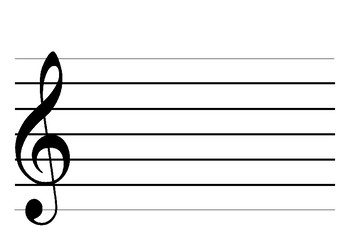Learning to read music was a little more tricky than I thought it would be. For starters, I expected the staff (the lines the music is on) to be the same as when I played the trombone, and look like this:

Instead, the piano uses two combined staffs. One is for treble and one is for bass. The bass is the bottom and is usually played with your left hand, while the treble is the top and is played with your right. It look like this:

Besides this, I have also learned that "Every Good Boy Does Fine" (The acronym for remembering note positioning) only relates to the Treble staff, and as the notes go down to the bass staff, it becomes "Good Boy Do Fine Always" (or "good burritos don't fall apart"). It looks something like this:
I have also learned which notes correspond to which keys since there are several different keys that correspond to a letter (for example there are 8 c's). There is a system where the keys are put onto extra lines called ledgers. As the keys go from bottom to top on the staff, they go from left to right. It looks something like this:
There are many other things I have picked up from my research including what middle c is, what flats and sharps are (the black keys), what ties are, what whole, quarter and eighth notes are and a lot of other information, but I'm not going to bore you by giving you every little detail.
Other than reading music, I have also been working on my playing by doing my exercises every chance I get. I also got to playing a riff from one of my exercise videos that really shows how far I have come. It involves both hands and switching keys with both hands at the same time. Here is me playing it:
This week was also full of learning that doesn't just involve playing. There are 3 big takeaways that I think are worth sharing:
1. Start Slow
When I first begin to learn and exercise or song, it helps when I start slow. Once I get the notes down I can get a feel for how to move my fingers. Then I can start going faster and after a lot of practice I will be able to play whatever I am attempting.
2. With Enough Practice (almost) Anything is Possible
While it might be a while until I can play "Flight of a Bumble Bee", I can still play a lot more than I may think. When I sit down to play an exercise, it may seem difficult, but by going slow and taking it step by step, I can surprisingly play some difficult pieces (at least for a beginner). Basically I have learned that I shouldn't count myself out and should attempt something before I think it is too hard.
3. Don't Disadvantage Yourself
When I first started playing, I would do things like only use my thumb, index finger and middle finger. Small things like these can really effect my playing as I begin to play difficult works. Using only three finger makes my hand more tired and prevents me from playing certain notes. The reason many beginners do this is because the last two finger are usually weaker and not as independent. By exposing them to playing and using them more, they begin to get stronger. Since I am just starting, this lesson is very important, and I have learned that doing the correct things and playing the correct way will make playing later a lot easier.
Learning the piano has been a completely new experience to me. It is nothing like sports. It requires a level of patience and technique that isn't necessarily more difficult, but is different. I am beginning to understand what it is like to play an instrument, and am enjoying exploring a new interest. I have learned so much already and hope to keep it going in the next several weeks. I also hope to be able to keep this same level of interest as my journey goes on.
Helpful sources so far:
Cazaubon, Mantius. “How to Read Piano Notes.”
Piano-Keyboard-Guide.com
^^^(Helped with reading music)
Inspired, Musicians. "How to Read Notes Fast - The Landmark System." Youtube.com, Nov 4, 2017.
https://www.youtube.com/watch?v=jSOU-J9KHbg
^^^(Helped with reading music)
MangoldProject. "5 Simple Piano Exercises For Building Technique." Youtube.com, Apr 23, 2016.
https://www.youtube.com/watch?v=kfWMTC9aRx8&t=29s
^^^(Helpful exercises I warm up with every time I practice)
One of the hardest fundamentals of piano is learning to simultaneously play with two hands. In some cases, each hand can be playing entirely separate melodies with two different dynamics. When I was learning new music, I found it easier to learn one hand at a time. Great takeaways, as well!
ReplyDeleteAwesome! Great job Jakey! It's great to see how far you've come already! I believe that you can become the next Mozart. Keep grinding!
ReplyDeleteGreat post bud! It was very cool to see what you learned, and the addition of pictures positively contributed to my understanding of what you are learning. I agree with Adam in that you are probably going to be the next Mozart.
ReplyDelete